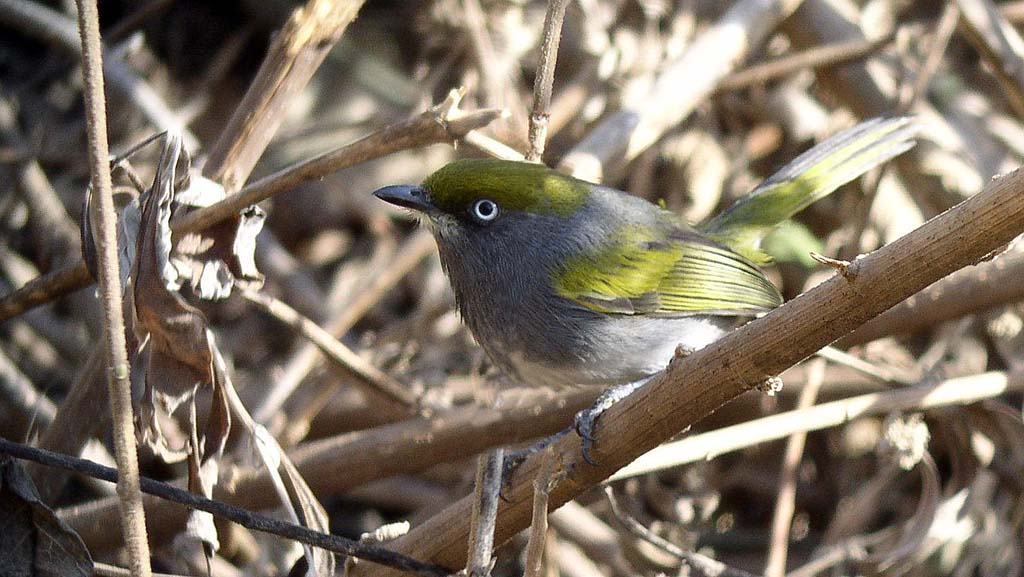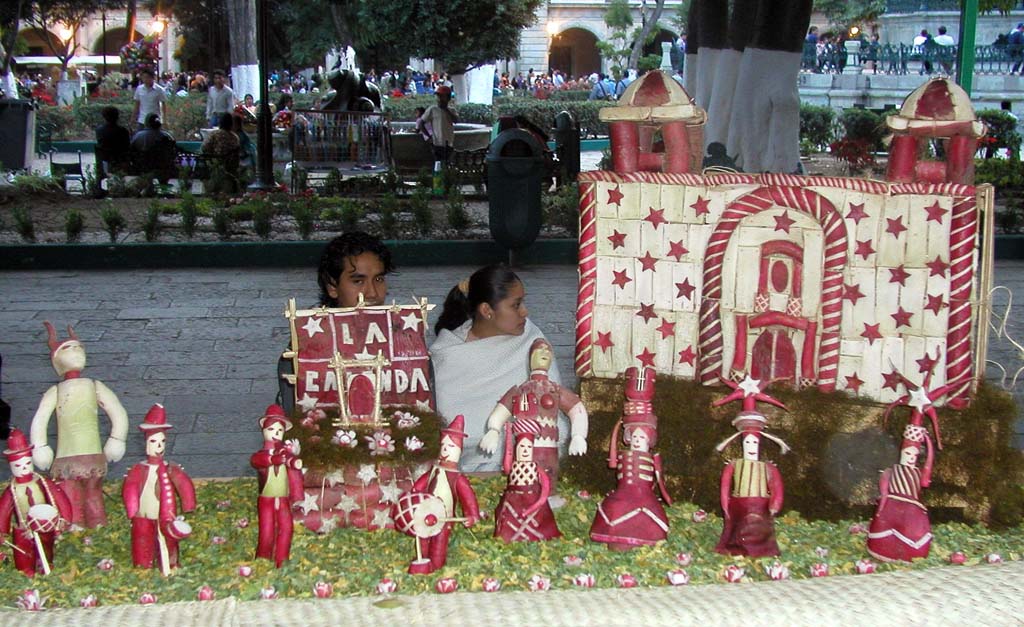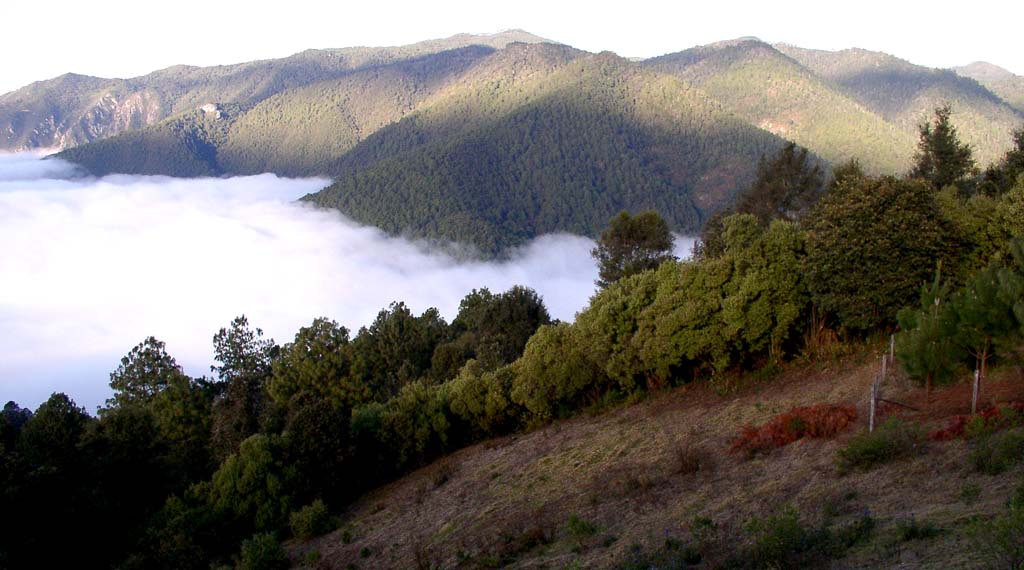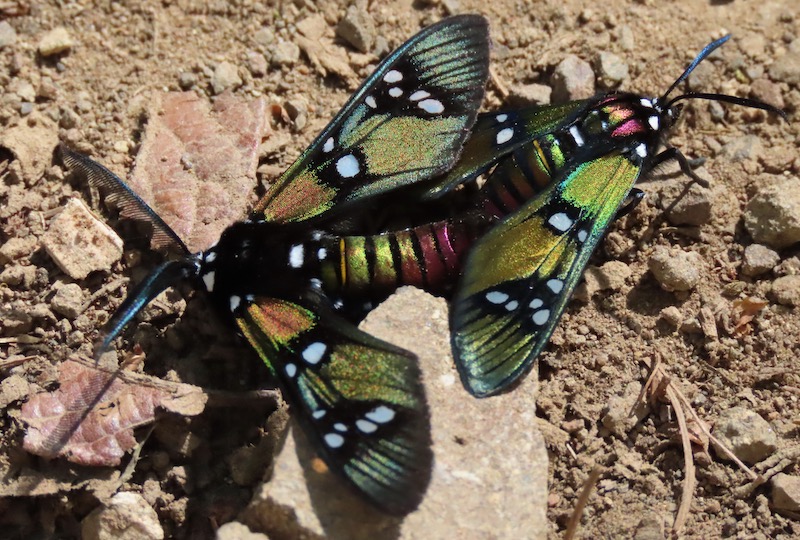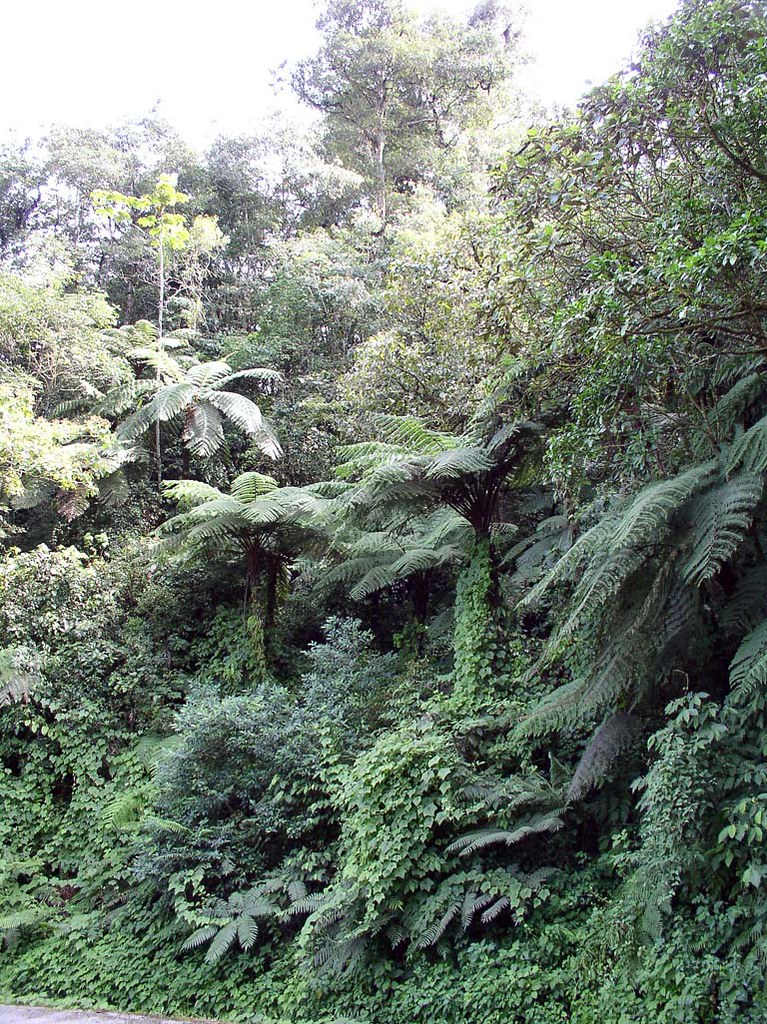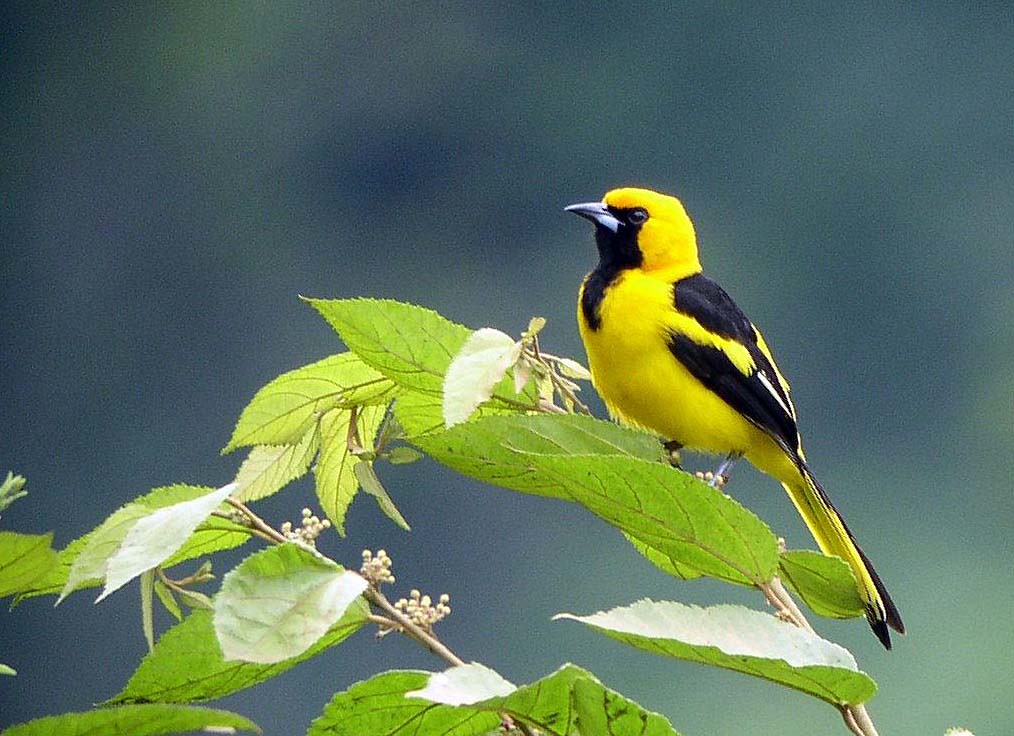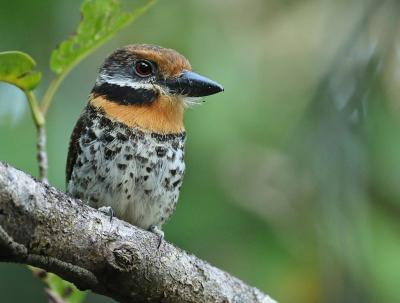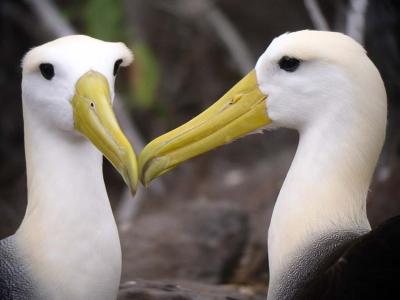Mexico: Oaxaca at Christmastime
-
Dec 22-31, 2025
Rich Hoyer
Tour Price to be Determined
Tour Price to be Determined
The city of Oaxaca lies in an arid valley ringed by mountains in south-central Mexico. The site has been occupied for centuries, as evidenced by the old architecture and nearby pre-Columbian ruins, but the city remains rather small and retains a vibrant atmosphere. And although Oaxacan handicrafts offered in the colorful markets have lured travelers from all over the world, the visitors have not changed the town’s unique flavor. When Oaxaca celebrates the holidays, it is perhaps the most Mexican of all cities. The area has also acquired a reputation among birdwatchers, for in the immediate surroundings of the city one can find a variety of habitats, from desert and oak thorn-scrub to pine and cloud forest. Birds of at least three distinct faunal regions occur here, among them many of Mexico’s most notable endemic species. This trip departs somewhat from the normal pattern of our tours: mornings will be spent birdwatching, but some afternoons will be devoted to cultural events in Oaxaca City (such as the Noche de Rábanos), exploring a couple markets, or visiting ruins. The trip is designed for the person wanting to take a Christmas vacation, experience the holidays in the surroundings of a different culture, and see a number of Mexico’s rare endemic birds.
Day 1: The tour begins at 6:00 pm in Oaxaca City. Our comfortable hotel is perched on a hillside with a splendid view of Oaxaca City. A good restaurant, shuttle service to downtown, and a pool round out the important amenities. Night in Oaxaca City.
This is, by far, one of the best birding tours EVER for me. The location with its birding opportunities, the time of year (Christmas getaway!) and the general pace of the tour were great. Of course, all of this was made possible by Rich Hoyer who was a fantastic guide, sharing his love for this region of Mexico and his endless enthusiasm for the natural world. - Alane G.
Days 2-5: Our explorations will begin the morning of day 2. Each of our forays afield will concentrate on a particular habitat, with ample time to observe the common birds and seek out the rare or more retiring ones. Visiting thorn-scrub and arid oak forest north and southeast of town, we expect to see Dusky Hummingbird, Gray-breasted Woodpecker, Rufous-capped Warbler, Bridled Sparrow, and perhaps the very local Oaxaca Sparrow. Exploring the higher elevations on Cerro San Felipe north of town, with stops in pine-oak, fir, and cloud forests, we’ll look for Chestnut-sided Shrike-Vireo, Mountain Trogon, Gray-barred Wren, Cinnamon-bellied Flowerpiercer, Collared Towhee, and Rufous-capped Brushfinch. Warbler flocks should include migrant species from the north mingling with the local Crescent-chested and Red Warblers and Slate-throated Redstart. And of course we’ll search for Dwarf Jay, the specialty of Cerro San Felipe.
We’ll also bird near and in the famous ruins of Monte Albán and Yagul. Located on lower hills near the main valley, species here might include Pileated Flycatcher, Boucard’s Wren, Beautiful Hummingbird, and Gray Silky-flycatcher. There will even be some time to bird on the hotel grounds in your spare time, where White-throated Towhee, Tufted Flycatcher, and Slate-throated Redstart might mingle with the many migrant Nashville and Yellow-rumped Warblers.
Days 6-8: We’ll make a two-night, three-day side trip to Tuxtepec in the Gulf of Mexico lowlands. The distance to Tuxtepec is only 130 miles, but because of the winding mountain road and several birding stops along the way, we’ll reach our hotel in the late afternoon. The road above Valle Nacional passes through one of the finest stretches of cloud forest in Mexico. This road is rich in birds, virtually none of which can be found in the Oaxaca Valley. Here we may see White Hawk, Montezuma Oropendola, Slate-colored Solitaire, Azure-hooded and Unicolored Jays, Emerald-chinned Hummingbird, and many others characteristic of this more humid forest. Closer to Tuxtepec, we’ll enjoy birds of a rather tropical flavor, such as Band-backed and White-bellied Wrens, Yellow-tailed and Black-cowled Orioles, Keel-billed Toucan, Rufous-breasted Spinetail, and many other species that will boost our trip list. We even have a small chance of seeing the Mexico endemic Sumichrast’s Wren.
Days 9-10: We’ll have two nights and one final day based out of our Oaxaca City hotel to visit some new locations in the interior valleys or perhaps return to the pine-oak if any specialties still elude us. We usually drop down a few kilometers into the Tehuantepec drainage into a beautiful giant cactus woodland where White-lored Gnatcatcher, Nutting’s Flycatcher, Banded Wren, Rufous-naped Wren, or Elegant Trogon could be trip additions.
With the exception of our travel days to Tuxtepec, we finish birding most days with lunch and an afternoon stop or two to examine local rugs, textiles, and handicrafts in the open-air markets. On the way back to the hotel one of the days we may stop to ogle at a famously huge and ancient tree. On a couple days participants even will have time to honor the Mexican tradition of the afternoon siesta, or else take a personal trip to re-visit the nearby Monte Albán ruins or simply walk around town enjoying the architecture and absorbing the festive spirit of the season.
The tour concludes in Oaxaca City on the morning of Day 10.
Note: The information presented here is an abbreviated version of our formal General Information for Tours to Mexico: Oaxaca. Its purpose is solely to give readers a sense of what might be involved if they take this tour. Although we do our best to make sure that what follows here is completely accurate, it should not be used as a replacement for the formal document which will be sent to all tour registrants, and whose contents supersedes any information contained here.
ENTERING MEXICO: Mexico requires of U.S. citizens a passport valid for at least six months from the date of entry and with a least one blank page for an entry stamp. Tourist cards are required and are distributed by your entering airlines. Citizens of other countries may need a visa and should check their nearest Mexican embassy.
COUNTRY INFORMATION: You can review the U.S. Department of State Country Specific Travel Information here: https://travel.state.gov/content/travel.html and the CIA World Factbook here: https://www.cia.gov/the-world-factbook/. Review foreign travel advice from the UK government here: https://www.gov.uk/foreign-travel-advice and travel advice and advisories from the Government of Canada here: https://travel.gc.ca/travelling/advisories.
PACE OF THE TOUR: We plan to be in the field at dawn, about 6:45 a.m., which means a 6:00 a.m. departure most days, and a 5:30 departure on at least two. Birding sites are usually 30-45 minutes from the hotels. We usually finish our day’s birding before lunch, after which we’ll stop at a ruin, market, or the Tule Tree of more cultural interest, getting back to the hotel between 2:00 or 4:00 with time off until our checklist session and dinner starting at about 6:00. On one day we are back at the hotel for lunch, followed by a siesta and a 4:00 p.m. departure for the Noche de Rábanos downtown. We offer owling on one day, one starting with an early picnic dinner in a beautiful pine-oak forest.
Birding in and around the valley of Oaxaca is from 5,300 to 6,000 feet in elevation. Birding around the Monte Albán ruins involves walking on uneven ground. Some trails are narrow, scrubby, and thorny (shorts not recommended). There are short series of steps and some moderate slopes within Monte Albán as well as at Yagul.
The drive to and from Tuxtepec takes a full day (with birding stops) on a paved two-lane highway. On those two days, we start with a 5:30 departure. During our full day at Tuxtepec we bird all morning but come back to the hotel for lunch; an optional birding outing is offered in the afternoon.
One Tuxtepec trail we hope to take in search of Sumichrast’s Wren is about a half mile round trip on very uneven and highly eroded rocky limestone in the forest understory. We proceed very slowly and carefully but those who find this one outing too treacherous may wish to stay back at the vehicle for the two hours or so that we bird here. On Cerro San Felipe above Oaxaca City, we will be birding on dirt roads at about 9,000-9,900 feet. We will be walking slowly at this elevation, but some stretches of road are steep and pose possible difficulties for those with bad knees or hips. A hiking stick might be useful.
Throughout the tour we do lots of standing and watching, and we generally move very slowly. If this tends to tire your lower back a small, lightweight travel stool that you can carry with a strap over your shoulder would be useful.
A small amount of group time will be devoted to outings of a more cultural interest, such as visiting the Night of the Radishes, viewing the calendas, seeing the famous Tule Tree and spending about one-half hour each at several of the markets and ruins. We’ll be at Monte Albán and Yagul ruins a bit longer but birding during that time. Some people may find our limited time in these locations too brief; you may wish to consider arriving earlier or staying on after the tour to enjoy the rich cultural offerings of Oaxaca at this season.
The Midnight Mass on the 24th is an attraction for some, Fridays offer a Guelaguetza dance performance, museums and an ethnobotanical garden are popular attractions, and several outlying villages are frequent tourist destinations for their market specialties. Arrangements to visit all of these can be made through the transportation company we use or with the travel desk in our Oaxaca City hotel.
HEALTH: The Centers for Disease Control and Prevention (CDC) recommends that all travelers be up to date on routine vaccinations. These include measles-mumps-rubella (MMR) vaccine, diphtheria-tetanus-pertussis vaccine, varicella (chickenpox) vaccine, polio vaccine, and your yearly flu shot.
They further recommend that most travelers have protection against Hepatitis A and Typhoid.
Malaria: The CDC recommends travelers to rural areas in the Mexican state of Oaxaca are at risk for malaria. We presume they mean only the tropical elevations such as near Tuxtepec, where we do spend two nights. In reality, Malaria is extremely rare here, and our leaders never take prophylaxis. Please consult your physician.
Please contact your doctor well in advance of your tour’s departure as some medications must be initiated weeks before the period of possible exposure.
The most current information about travelers’ health recommendations can be found on the CDC’s Travel Health website here: https://wwwnc.cdc.gov/travel/destinations/list
Elevation: The Valley of Oaxaca is situated at between 5,300 and 6,000 feet. On Cerro San Felipe we’ll be birding (slowly) between 9,000 and 10,000 feet. Please consult your physician if you have cardiovascular issues.
Smoking: Smoking and vaping is prohibited in the vehicles or when the group is gathered for meals, checklists, etc. If you are sharing a room with a nonsmoker, please do not smoke in the room. If you smoke in the field, do so well away and downwind from the group. If any location where the group is gathered has a stricter policy than the WINGS policy, that stricter policy will prevail.
Miscellaneous: Sun in Mexico can be very intense. Please bring adequate protection, including a sun hat and a strong sun screen of at least 15 rating. We have found that with careful eating habits, intestinal problems can be largely avoided.
Immodium or Pepto Bismol in tablet form can be recommended as the best treatment for occasional traveler’s diarrhea. Gatorade or other electrolyte-replacement drinks in powder form are also worth bringing, as they replace the vital salts and minerals lost during a bout of diarrhea.
Biting insects and arachnids are seldom a major nuisance although chiggers and biting gnats can be locally numerous at Tuxtepec, and there may a few mosquitoes active in the late afternoon/early evening even in Oaxaca; only those who are attractive to them and are senstitive to such bites will even notice. Careful application of repellent provides good protection and the leader will advise you when it will be necessary. In general, a repellent should contain 30% of the active ingredient, diethyltoluamide (DEET).
The best prevention against chiggers (but also somewhat helpful against mosquitoes) is to treat your clothing with permethrin one to a few days before you leave home. This non-staining, odorless chemical is non-toxic to humans and protective on clothing through several launderings. Camping supply and drug stores sell sprays containing 0.5% permethrin, while online sources also offer pump sprays as well as a more economical 10% concentrate which you dilute and then treat clothing by soaking it in a large bag and then hang out to dry; be sure to look into this option well in advance of the tour. (One currently available brand is Duration, from Traveler’s Supply, Inc., https://www.travelerssupply.com/).
In most of Mexico it is unwise to drink untreated water. We will be carrying bottled water and other drinks with us during our days.
CLIMATE: This is the dry season, but we are far enough from the equator that cold fronts from the North America can have a strong effect. Near Oaxaca City and in the mountains early morning temperatures can be quite cold, in the 30°s F. If it’s clear and calm after a cold front, frost is even possible. During the passage of a cold front, a persistent mist and fog with wind at 45°F can feel even colder, and the high temperature in the mountains may not get much higher than 55-60°F. But most days it’s very pleasant, a chilly 45-50° first thing in the morning, then an hour or two after sunrise the temperatures rise with the sun, peaking around 65-75° in the mountains and possibly up to around 85° in the valley and at Tuxtepec (where it also much more tropically humid). We rarely encounter heavy rain, but light rain or mist is possible in some areas, especially on our trip to Tuxtepec.
In summary, you should be prepared with clothing layers, including gloves and hat, and if misty in the mountains above Oaxaca, rain/wind pants and jacket would be a good idea.
ACCOMMODATIONS: In Oaxaca City we stay in a very nice hotel on the hill overlooking the city. The extensive grounds have lots of trees and are surrounded by brushy habitat that can be full of birds. There is a swimming pool. We are not immediately next to downtown, but it is walkable and only a 10-minute (50 pesos) taxi ride; the hotel also provides a complimentary shuttle that runs every hour in the late morning and evening. In Tuxtepec our hotel is much simpler but still modern, with air conditioning, private baths, and a hotel restaurant. Wifi is available in both hotels.
FOOD: Breakfasts will be picnics in the field, generally consisting of hard boiled eggs, yogurt, cereal, fruit, etc. Most lunches will be in restaurants, either at our hotel or near our birding, with at least three picnics in the field consisting of sandwiches with cheese and cold meat, fruit, fresh guacamole (made in the field!), snacks and cold drinks. All dinners will be in local restaurants, with the exception of one picnic dinner which will be a bit more substantial than our lunches, followed by owling. In general, the food in Oaxaca City is excellent to outstanding and is often regarded as the pinnacle of Mexican cuisine, which is generally only hot if you add hot sauce to it; restaurants will warn you if any dish is naturally hot. Rich chile-nut sauces of several kinds, called mole, and local vegetables and side dishes are consistently raved about during the tour. We make a point to visit three or four of the top restaurants in the city.
Food Allergies / Requirements: We cannot guarantee that all food allergies can be accommodated at every destination. Participants with significant food allergies or special dietary requirements should bring appropriate foods with them for those times when their needs cannot be met. Announced meal times are always approximate depending on how the day unfolds. Participants who need to eat according to a fixed schedule should bring supplemental food. Please contact the WINGS office if you have any questions.
WINGS tours are all-inclusive and no refunds can be issued for any missed tour meals.
TRANSPORTATION: Transportation is by 12-passenger vans with a local driver. Participants should be able to ride in any seat in tour vehicles.
2023 Narrative
In Brief: The festive atmosphere, great food, cultural attractions, and above all, the great birds made Oaxaca a fabulous place to spend the last nine days of the year 2023. The ruins of Monte Alban and Yagul were complemented by a walk around the amazing carved radish displays for the 126th annual competition in the Oaxaca City square and a visit to an exquisite rug studio in Teotitlán del Valle. In between our cultural stops were bouts of birding where Elegant Euphonia, Red Warbler, Ocellated Thrasher, Slaty Vireo, Bridled Sparrow, Happy Wren, and White-tailed Kite were memorable sightings from the Oaxaca Valley and Cerro San Felipe north of the city. Our two-night side trip to the wetter Gulf of Mexico slope in the north of the state yielded Orange-billed Sparrow, Gray Hawk, Collared Trogon, and White-winged Tanager to name a few favorites among the more than 130 species that this side trip added to the bird list (almost doubling the total in just three days). To top it all off, we got to sample the rich local cuisine highlighted by several kinds of moles in a variety of local restaurants, tasted several varieties the locally produced mezcal, and enjoyed picnic breakfasts and lunches (and even one picnic dinner) in the field prepared by our wonderful driver Basilio.
In Detail: Our first morning saw us at the gate to Monte Alban for picnic breakfast with a chorus of Cassin’s Kingbirds greeting the day, joined by a single Thick-billed Kingbird. Just as breakfast was served, a surprisingly visible Blue Mockingbird joined the noise with its imitations of Cassin’s Kingbird and Western Wood-Pewee among others. We walked up the road to the ruins, seeing two Orange-billed Nightingale-Thrushes, a notorious skulker, and most of us at least heard a Blue Bunting female that popped up out of the undergrowth for a second – the first record for the Oaxaca Valley. The first of several Vermilion Flycatchers greeted us at the parking lot, and then after we entered the ruins, we continued birding around the perimeter before entering the central plaza. Rufous-capped Warblers were abundant and easy to see, a single Canyon Wren sang from the bushes, and a few Rock Wrens hopped about the ruins. After we had our fill of the impressive former city, a pair of stunningly beautiful Elegant Euphonias obligingly fed on the fruits of a mistletoe clump only a few feet away at eye-level. After a late lunch at Origen downtown, we walked around the zocalo, seeing the impressive work of local artists competing in the 126th annual Night of the Radishes festival. The corn husk and dried flower creations were almost as impressive.
Our second day of birding saw us in a totally different habitat, up in the mountains north of the city. We walked forest roads through the pine-oak, seeing about the same number of species as the first day, but with so little overlap we essentially doubled our trip list. A seldom-seen Pine Flycatcher right after breakfast was a nice addition, and we were able to compare it to a nearby Hammond’s Flycatcher and hear its distinctive call. A Collared Towhee surprised us by singing just a few feet away almost in the full open, while a Gray-barred Wren at the same location was also astonished by going up into an open bush in plain sight. We continued looking for mixed flocks, mostly finding warblers and kinglets, seeing several amazing Red Warblers, and stumbling into a single Golden-crowned Kinglet at the very southern edge of its range. When we found a large group of Gray-barred Wrens, we scoured it carefully for jays. The prize here though was a very responsive Northern Pygmy-Owl. As we were preparing lunch another wren flock was found, and in it was a group of the very local Dwarf Jay. After lunch the rest of the group was able to catch up with one of the jays, hanging out with Steller’s Jays, while we added Spot-crowned Woodcreeper and two very handsome Tufted Flycatchers. Dinner at Las Quince Letras featured a long list of different mole dishes in a festive atmosphere.
Christmas morning saw us at the Piedra Azul Reservoir. Our picnic breakfast was difficult to consume, owing to the abundance of birds in all directions diverting our attention. The water levels were quite low, reflecting a bad summer of rains, but perhaps responsible for concentrating the local rarities of White-faced Ibis, Northern Pintail, and Canvasback, the latter two new to the all-time list for this tour. Lots of sparrows and warblers coming to the water were joined by a Blue Grosbeak, while a very confiding Black-vented Oriole fed in a tree morning glory. We struggled to find birds of any kind in the lower foothill scrub, the driest it’s ever been, but astounding was a Oaxaca Sparrow foraging out in the open on the road shoulder when we arrived. A little higher in the canyon the forest was a bit moister, and here we found Painted Redstart and our only Red-faced Warbler of the tour. A delightful lunch in the pine-oak zone was accompanied by a mixed flock of Steller’s Jays and Gray-barred Wrens with a single female Black-backed Oriole, something of a rarity here. A final highlight of the day was a gleaming White-tailed Kite by the highway just outside the town of El Tule.
We started Boxing Day below the little-visited ruins of Yagul in a rather different habitat dominated by columnar cactuses, acacias, and mesquite. A couple of Curve-billed Thrashers performed nicely when we arrived, but the local Boucard’s Wrens were clearly waiting for the sun to creep a bit higher before announcing their presence. Bridled Sparrows were decidedly on the tardy side, giving us their best views only as we were about to leave the ruins. We drove for a bit to dip into the Pacific Coast avifauna on the highway towards the Isthmus of Tehuantepec, and the dry wash did not disappoint. Streak-backed Orioles were in small groups, a single female Orange-breasted Bunting was joined by a female Varied Bunting, and two pairs of Orange-fronted Parakeets announced their presence on the hillside. At our farthest point, a pair of handsome Rufous-naped Wrens charmed us as did a male of the adorable White-lored Gnatcatcher. This was our night to try for owls up at La Cumbre, though the full moon did not portend well. Indeed, just as we finished our dinner, a Mexican Whip-poor-will called right by the vehicle a few times, then stopped. Over the next 2 ½ hours we walked slowly, listened, and played the songs of five species of owls, and not a single bird responded.
After four days birding out of Oaxaca City, it was time for a bit of a change. Our first stop on the way to our two-night stay in Tuxtepec was in the Rio Grande Valley. The tropical thornscrub here was packed full of birds, and we breakfasted with the constant chatter of Gray Silky-flycatchers and singing Brown-backed Solitaires. Right by our breakfast spot was a pair of the scarce Rusty-crowned Ground-Sparrows in one of the only places where the species occurs on the Atlantic side of the continental divide. A Common Black-Hawk was sitting on a rock in the river where a Belted Kingfisher flew by. While trying to get looks at a joyous pair of Happy Wrens, we became the happy ones when a stunning Slaty Vireo moved through the roadside thicket. A bit more driving and we found ourselves in the drastically different cloud forest with ferns and orchids everywhere. Slate-colored Solitaires were silent, but we spied a couple feeding in fruiting trees, while in a mixed flock dominated by Common Chlorospinguses we teased out an attractive Scaly-throated Foliage-gleaner. We descended through a belt of fog, arriving in the lower elevations to find a Gartered Trogon perched over the road on the low powerlines. A nice flurry of activity followed, with our only Azure-crowned Hummingbird, a write-in Black-cheeked Woodpecker at the very northern edge of its range, and a super confiding Rufous-browed Peppershrike in the weedy vegetation on the roadside.
A day in the lowlands near Tuxtepec targeted the very local Sumichrast’s Wren, and those who dared the rough limestone trail in the forest understory got a very good auditory experience with a close one. It didn’t show however, and with the passing of a cold front, the forest was very quiet; perhaps the big mystery raptor that flushed from the canopy had something to do with it as well. On the open road, though, bird activity was super high, with loads of Orchard Orioles, a Yellow-breasted Chat, Yellow-olive Flatbill, and a clean sweep of all three saltators – Buff-throated, Cinnamon-bellied, and Black-headed all vying for our attention. One fortuitous roadside stop before lunch resulted in a surprise pair of Double-striped Thick-knee, barely known from this part of Oaxaca, a gorgeous male Summer Tanager perched in the open, and a wintering White-throated Flycatcher in its typical but rather un-empidonax-like habitat of open grass. Our sharp-eyed driver Basilio spotted an Aplomado Falcon perched by the road on our way to lunch. After lunch we birded our way up to the Cerro de Oro dam where we found a scarce Blue-winged Warbler, a very responsive pair of Ferruginous Pygmy-Owls, and American White Pelicans feeding below the dam, reminding us of summer back north.
The pre-dawn weather on our way to picnic breakfast for the return drive to Oaxaca didn’t look so great. But as it dawned near Valle Nacional, the skies dried out, visibility improved, and Basilio did it again by spotting a Bat Falcon perched on an antenna right in town. We drove only a few curves up into the lower cloud forest for breakfast at a spot that looked promising. Activity was nicely moderated – a constant trickle of good birds kept us on our toes. A normally very secretive Blue-black Grosbeak fed on the shoulder of the road, and a stunningly red male White-winged Tanager sang from a small treetop, later joined by his yellow female. A trio of Rose-breasted Grosbeaks included a young male that had the full rose-red bib. Back at the breakfast spot, a write-in Orange-billed Sparrow sang and skulked in the undergrowth right by the van, while checking the more distant trees resulted in a scarce Olive-sided Flycatcher and a troop of Collared Aracaris. The only Keel-billed Toucan was only in flight, but in full sight. We arrived at our big lunch pullout with an hour and a half to bird the middle-elevation cloud forest, hampered a bit only by fog and intermittent drizzle. We soon spotted a Wedge-tailed Sabrewing feeding on roadside flowers and a very handsome Rusty Sparrow came out of the very dense bushes to have a look. Crested Guans were a nice surprise quietly bounding through the trees, and a Stripe-tailed Hummingbird came out of hiding to forage on a red canna. We made only one more stop in the cloud forest when a flock of Unicolored Jays stopped in trees over the road, after which we exited the clouds and fog once we descended into the rain shadow of the Sierra. An almost-coincidental mini-reunion on the highway with some friends of Rich embarking on a multi-day trip to the north of Oaxaca and Veracruz gave us an opportunity to stretch our legs and enjoy a Yellow-bellied Sapsucker before continuing the long drive back to the city.
We tried something new for our last morning, birding some lower foothill thornscrub close to the city rather than going back up to what looked to be a chilly and foggy La Cumbre. The tree morning glories were abuzz with Dusky and Berylline Hummingbirds, and we had more views of female Beautiful Hummingbirds in the lower bushes. Chipping, Lark, and Bridled Sparrows were joined by Ash-throated and Nutting’s Flycatchers for a busy morning. A lovely White-tailed Hawk greeting the sun from a perch was yet another nice spot by Basilio. After our breakfast we concentrated on searching for birds we were still hoping for, finding our second Slaty Vireo along the way. Then thanks to a tip from Micah Riegner and Dan Lane who had been here a few days earlier with their Field Guides group, we connected with a very close and skulking Ocellated Thrasher, followed by a pair of the deceitful Dwarf Vireos, looking so much like Ruby-crowned Kinglets. We had great views of a lovely Audubon’s Oriole on the way out, then stopped by a small reservoir where we added Savannah Sparrow and Gadwall to the trip list, also finding an unusually easy to see Louisiana Waterthrush. Lunch was followed by a walk around the amazing El Tule Montezuma Baldcypress tree, and a fitting farewell dinner was at the splendid La Olla.
- Rich Hoyer
Rich is an excellent leader. His ability to call birds in, vary his "owl" dialects, and get participants seeing the birds is stellar. He has attention to detail for every aspect of the tour start to finish!
- Kathy C. on Mexico: Oaxaca at Christmastime
This is, by far, one of the best birding tours EVER for me. The location with its birding opportunities, the time of year (Christmas getaway!) and the general pace of the tour were great. Of course, all of this was made possible by Rich Hoyer who was a fantastic guide, sharing his love for this region of Mexico and his endless enthusiasm for the natural world.
- Alane G. on Mexico: Oaxaca at Christmastime
Maximum group size eight participants with one leader.


